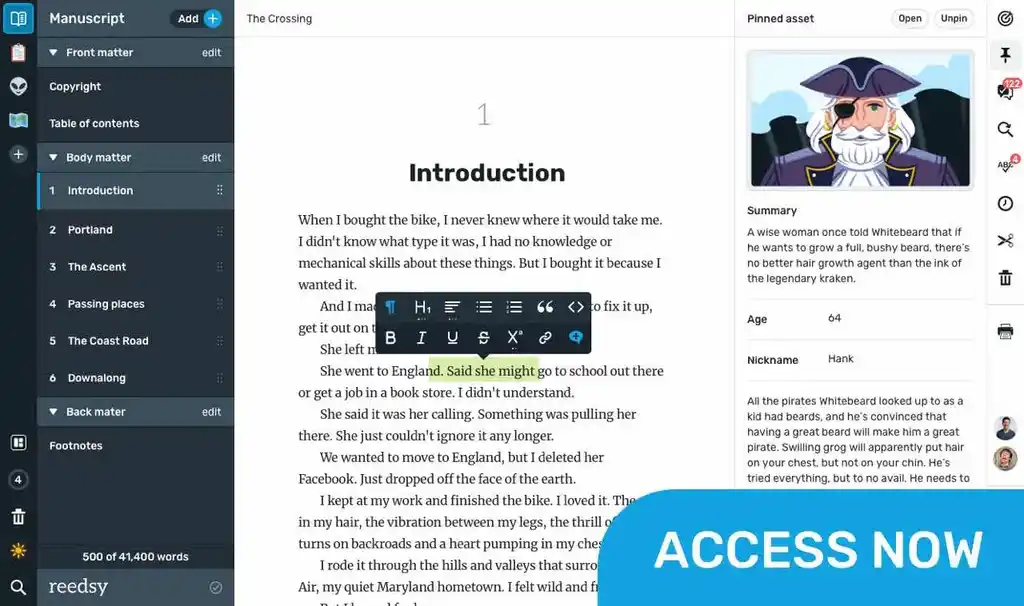In learning how to write a rough draft, there's no one-size-fits-all approach that suits every writer equally. This being said, writing a story draft as quickly as possible helps. Working quicker for the first pass helps to keep you from becoming discouraged or losing interest in your story idea. If you need to speed up your first draft, try a few of these tactics and see which ones help you progress faster:
1. Set a goal before you start
Set a goal that will give you an idea of how many words or pages you need to complete each writing session.
Because your goal is to write fast, your target should be fairly ambitious. If you really find yourself falling short you can go back and change your goal, but keep in mind that the idea is to push yourself and focus on quantity and putting ideas down loosely at this stage. Polish, shine and captivating chapter beginnings, middles and endings come later.
Although writing 'by the seat of your pants' (pantsing) may sound a faster way to draft, plotters have the advantage of having laid pathways for the story beforehand:
2. Start with an outline
Using an outline increases your writing speed. Why? The more structure you put in place before actually writing, the easier it will be to keep going. You don't have to stop as much to think about where your story will take your characters next, or primary story conflicts.
Once you start writing scenes and sequences and chapters the basic structure - one that you can deviate from as needed - is there. Try using boards in our Studio app to gather the loose strands of your ideas and weave them into a richer story tapestry.
Whether or not you have an outline, here is another approach that will help you finish writing a book faster:
3. Create basic scaffolding
Scaffolding is pre-decided structure that's not quite as detailed as a full novel outline. Let’s say you're aiming for a draft of about 50,000 words:
First, divide your word count into three acts. Your first and third acts could be 12,500 words long. Your second act could be 25,000 words long.
Secondly, consider the key moments of each act and where you want to place them:
- In act one, you’ll need an opening to establish your character(s) and world. There'll be an inciting event or multiple smaller events that set off multiple story arcs. You should choose roughly where in your first 12,500 words these will occur
- The middle section of your novel is where you tease out the initial themes and events of your novel and work in character development
- In the final third, the plot must reach a climax and a resolution (or open-ended non-resolution, if you prefer)
This basic scaffolding approach is different from creating a full plot outline. If you're a pantser you can use this approach because it is not necessary to know what the specific plot points will be until you are writing your draft. This looser approach still gives you a sense of pace to aim for.
The key is to remember a first draft vs a final draft is an entirely different prospect. It can be messy. You can see the scaffolding still (you'll take it all out when you revise, anyway).
4. Strip down your first draft to the simplest elements
Your first draft might not have crazy plot twists or subplots, or all kinds of richly detailed secondary characters. This is fine. It's easier to write a rough draft fast when you're focusing on the main, most important events and facts.
Some ways you can simplify your first draft:
- Put in stage-like directions instead of detailed scene transitions : E.g. [They travel for 2 days to the border - work out additional events that connect to further developments later.] This gives you the freedom to keep moving when you're not sure what comes next
- Leave out complex description: You could also try keeping your description simple, for now. Add place or character description to characterize and create tone and mood when you have the skeleton of your story complete, if this mode of working stops you from getting hung up on the details
To draft faster, also give yourself the freedom to work on story sections out of order, if you like. Just remember to write a sentence or two for even the chapters or sections you leave out. Indicate in your notes rough ideas for what will happen, and come back to this moment when you're satisfied with your ideas for what to include.
Your final novel should have a narrative arc that makes sense. Yet you don't have to construct your novel's rough draft sequentially in the chronological way the final book will be read.
Here are some other methods for fast, rough drafting:
5. Write looser using modified free writing
'Modified' free writing can be a great way to speed up your writing. In regular free writing, you would sit and write anything on a specific subject (or anything that pops into your head) for a designated amount of time. This may be useful in the planning stages, but it is not necessarily the best way to push your novel forward.
However, you can still do a kind of free writing when you are working on your novel. For example, if you have some idea of where a current scene is going, see how quickly you can write it without stopping to think or self-edit. Allowing your mind to make subconscious connections without turning on your critical, editorial voice is a good skill to develop.

6. Set creative limits
You can also try going in the opposite direction and set rigid but creative limits for yourself:
For example, pretend that you are writing your novel as a series of blog posts and you only have 350 words for each scene.
Alternatively, imagine that your book is a serial and that readers are getting short segments daily. Since you are writing quickly, you will want to write more than one short scene or segment in each writing session, but this can be a good way to force you to be efficient in each scene and include only the most important details and then move quickly on to whatever comes next.
This exercise is helpful because it will teach you to be succinct and precise so that you avoid cluttered writing.
7. Use an accountability partner
Partnering up with a writing friend (or a writing coach) is a useful way to stay focused and determined. People who work with a writing coach tend to develop deep commitment to their stories, and having someone to bounce ideas off is useful in those moments where you doubt your own intuition. Setting deadlines for yourself or together with your accountability partner is a small step, and finishing your entire book is a series of these conscious steps.
Once you have a draft down on paper, you can begin to shape it into the novel you'd love to write - and read. Several of the rough draft writing techniques outlined above can be combined. For example, you can mix creating an outline with basic scaffolding for a clear sense of general structure and direction.
Whether you are a planner or a pantser, its possible to finish your first draft fast. It's a simple matter of finding the process that works for you.










Even though I created an outline for my draft I have to completely rewrite my novel unfortunately due to massive POV errors. Then I realized that I didn’t like certain elements in my story that I wanted to delete. As a long time pantser I assumed that it would be easier for me to have an outline, this is true but I am disappointed in myself that I have to rewrite the entire story again. Is there anyway to check an outline to avoid these types of mistakes? Or is it just inevitable until after finishing the first draft? I want to avoid making the same mistakes I did previously.
Marissa - About 8 years ago
Always useful! :)
Lita Brooker - Over 7 years ago
Thanks so much, Lita! Thanks for reading :)
Bridget At Now Novel - Over 7 years ago
Great advice. Thank you.
Geekybird - Almost 6 years ago
Thank you, geekybird! We're glad to help :)
Jordan At Now Novel - Almost 6 years ago
very useful, thx
Rory Herlitz - About 5 years ago
Thank you for your feedback, Rory! Happy New Year.
Jordan - Almost 5 years ago
its so cool! i loved the help!
Joe - Almost 5 years ago